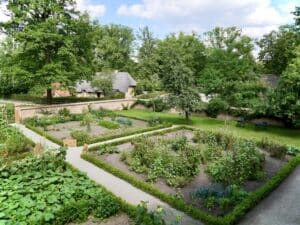Bush Tucker Plants For Beginners: A Gardener’s Guide in Victoria

If you’re keen to add a dash of variety in your vegie garden, it’s time to welcome the bush natives to your garden. In this beginner-friendly guide, we’re diving into the vibrant world of bush tucker plants, Australia’s own edible greens. Read on to discover how these homegrown stars can sprinkle some Aussie magic on your garden and dinner table. Here is Diaco’s Bush Tucker Plants for Beginners:
Why Bush Tucker Plants?
Bush tucker (or “tucka”) plants are the local heroes not just in your garden but also on the dining table, thanks to their edible and often nutritious bits like leaves, fruits, seeds, and roots. There is a long history of use that goes back thousands of years. Here are some great reasons to share some bush food love in your veggie garden:
New Tastes
Bush native plants introduce you to a world of new flavours. From the tangy kick of bush tomatoes to the salty crunch of samphire, your taste buds are in for a treat!
Easy to Grow
Many of these plants are hardy and adapted to our local soils and climates. They’re not fussy, making your gardening journey a breeze.
Health Benefits
Packed with beneficial nutrients, bush tucker plants are a healthy choice. It’s nature’s way of packing nutrition right into your garden.
Water-Savvy
With their native roots, many bush food plants are drought-tolerant. They don’t ask for much water, which is a thumbs up for conserving this precious resource.
Pest-Resistant
These native buddies have grown alongside local pests for ages and have built up a good defence. That means fewer headaches dealing with pesky bugs and more time enjoying your garden.
Getting Started in Victoria
Victoria’s climate is a welcoming spot for many bush tucker plants. The mild winters transitioning to warm or hot summers create a good environment for these native plants. Understanding Victoria’s climate and how it interacts with these plants is the first step in your bush food gardening journey.
Local Climate
Victoria’s climate varies from milder coastal areas to different temperature ranges inland, making it suitable for a variety of bush tucker plants. Whether you’re near the coast or further inland, the climate in Victoria is conducive for these native plants to grow well. Each region has its unique climate characteristics that can be matched with the right bush tucker plants to ensure successful growth.
Soil Preparation
Good soil is the foundation of a healthy garden. Preparing your soil with organic matter and ensuring good drainage is crucial for your bush tucker plants to thrive. Mixing in organic matter helps improve soil structure and provides the nutrients these plants need to grow healthy and strong. Good drainage is essential to prevent waterlogging, which can be harmful to your plants.
Watering
Bush tucker plants are generally low-maintenance when it comes to watering, especially once they are well established. Many of these plants are drought-tolerant and don’t require a lot of water to thrive. This characteristic makes them a smart choice for water conservation in your garden. However, regular watering, especially in the initial stages, helps them to settle in and grow well. As they grow, these plants will require less water, making them easy to care for while also being a water-wise choice for your garden.
Top Bush Tucker Plants for Victorian Gardens
Now, let’s meet some bush tucka stars that can shine bright in your Victorian garden:
Warrigal Greens
Warrigal Greens, also known as New Zealand spinach, are a sturdy and easy-to-grow choice for any garden. These plants are low-maintenance and adapt well to different conditions, which is great for both new and experienced gardeners. The leaves are similar to regular spinach but have a bit of a tangy kick. They grow in a sprawling manner and can reach a height of about 30-40 cm with a spread of up to 1m or more if left unpruned.
These greens aren’t picky about where they grow. They do well in a variety of soils, and once they’re settled in, they don’t need a lot of water to stay healthy. It’s a good idea to start them in a sunny spot with well-draining soil to give them the best start.
When it comes to eating, the leaves are where it’s at. They can be used in salads, stir-fries or anywhere you’d normally use spinach. Just wash them well, chop them up, and they’re ready to go. They bring a nice green colour and a fresh, earthy flavour to your dishes.
Saltbush
Saltbush is a strong, easy-going plant that is well-suited for dry or saline soil conditions, showcasing grey leaves that give a silvery touch to your garden. It’s a tough shrub that can handle dry spells well, showing off a dense foliage that can grow up to 1 to 2 metres in height and a similar spread.
One of the practical benefits of having saltbush in your garden is its ability to help with erosion control. It’s good at holding the soil together, which is especially useful in areas prone to erosion.
Now, let’s talk about the tasty side of saltbush. The leaves are edible and have a unique salty flavour. They are also nutritious, rich in minerals and antioxidants. You can use them in a variety of ways in the kitchen. They can be blanched, sautéed, or even used as a wrap for meats. You can toss them in salads or use them to stuff poultry. If you dry the leaves, they can be used as a herb or a salty sprinkle on your dishes, acting as a substitute for common salt or seaweed.
Bush Tomatoes
Bush tomatoes, or kutjera, are a nifty little addition to your garden. Unlike your standard tomatoes, these are smaller in size but pack a punch with a sweet, tangy flavour. They bring a unique taste, something different to your usual tomato dishes.
Growing bush tomatoes is pretty straightforward. They like a sunny spot in the garden and well-draining soil, much like their common tomato cousins. When they start to fruit, you’ll notice they are smaller, often about the size of a grape. They turn a bright red colour when ripe, indicating they are ready to be picked and enjoyed.
In the kitchen, kutjera can be used in a variety of dishes. They add a sweet and tangy kick to sauces, chutneys, and traditional Australian recipes. If a recipe calls for kutjera and you don’t have any on hand, sun-dried tomatoes could be used as a substitute. However, keep in mind that while sun-dried tomatoes bring a similar intense flavour, they won’t quite capture the unique taste of kutjera.
These little tomatoes can replace common fresh or sun-dried tomatoes in recipes where a more intense, tangy flavour is desired. They work well in salads, salsas, and sauces, lending a different taste profile to the dish.
Samphire
Samphire, often referred to as sea asparagus or sea pickle, is a crunchy, salty plant that could add a unique flavour to your garden and your plate. Growing to about 20 to 30 cm in height, it’s a modest plant with a big personality. The fleshy stems are what you’re after; they bring a salty, marine-like flavour to dishes.
In the kitchen, you can use Samphire much like you would use capers or olives. It goes great in salads, providing a crunchy texture and a salty kick. It’s also a fantastic side dish, lightly steamed or sautéed, maybe with a bit of garlic and butter.
Growing Samphire is pretty easy-going. It loves well-draining, sandy soil and plenty of sunshine. It’s used in coastal areas, so it doesn’t mind salty conditions. Once it’s established in your garden, it doesn’t need much watering, which is a bonus during those drier periods. It’s a low-maintenance plant that adds a unique flavour to your garden both visually and culinarily. One of the key things to remember when growing Samphire is to avoid waterlogged conditions. It likes its soil well-draining, so ensure it’s planted in a spot where it won’t be sitting in water.
Karkalla
Meet Karkalla, also known as pigface, a sturdy little plant that brings a touch of the coast to your garden. Standing at about 10-30 cm tall, it’s a low-growing plant with a spreading habit, perfect for ground cover or even hanging baskets. With its fleshy, succulent leaves and small but bright pink flowers, it’s a modest plant with a cheerful demeanour.
Growing Karkalla is pretty straightforward – sandy soil, a sunny spot, and occasional watering, especially during dry spells. It’s a hardy plant, tolerating salty winds and sandy soils, making it a great choice for coastal gardens or those drier, sunnier spots in your yard.
Now, let’s talk about the tasty side of Karkalla. Its leaves and fruit have a slightly sour taste which can add a zesty kick to your salads and stir-fries. They have a crunchy texture which holds well whether you decide to toss them in a salad or give them a quick stir-fry. And if you’re looking to replace capers or olives in a recipe, Karkalla could be a unique substitute.
Wrapping Up
Diving into bush tucker gardening in Victoria is a straightforward yet rewarding venture. It’s all about getting to know a variety of native plants that not only change up your vegie garden but also bring new flavours to your table. As these plants have adapted to the Australian soil and climate over thousands of years, they require less fuss and water than many common garden varieties, making them a smart choice for a low-maintenance garden.
At Diaco’s, we’re all about making gardening a joyful and rewarding experience. Our friendly team is here to guide you on your bush tucker gardening journey, sharing tips on the best plants for Victorian climates, how to care for them, and even a few recipe ideas to get you started. So, let’s explore some bush tucker plants for beginners together and discover how they can add a new dimension to your garden and your plate.
-
 5, Jul, 2025
5, Jul, 2025How to Create a Mediterranean Style Garden Using Australian Native Plants
Love the look of a Mediterranean style garden but want... -
 13, Jun, 2025
13, Jun, 2025How to Start a Garden Design Project: Step-by-Step Planning Guide for Beginners
At Diaco’s, we know that creating a beautiful garden starts... -
 27, May, 2025
27, May, 2025Smart Garden Layout Ideas: How to Maximise Your Outdoor Space
At Diaco’s, we believe every garden has potential. Whether you’ve...


